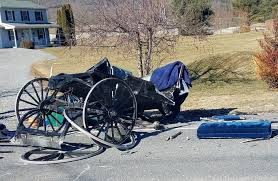
cLick Below to watch and engage
| Detail | Information |
|---|---|
| Victims | Glenda Jo, Darrell, and Devon Yoder |
| Ages | Between 9 and 13 years old |
| Date of Incident | Wednesday, April 09, 2025 (assumed morning) |
| Location | Fir Road, south of Bremen, Indiana |
| Cause | Collision between pony cart and car |
| Community | Amish community of Bremen |
| Outcome | All three siblings pronounced dead at scene |
Tragedy on Fir Road – A Heartbreaking Amish Buggy Accident
What started as an ordinary Wednesday morning in the quiet town of Bremen, Indiana, quickly turned into a day of unimaginable sorrow. Three young Amish siblings—Glenda Jo, Darrell, and Devon Yoder—set out on their daily journey to school, riding together in a pony cart along Fir Road. It was a routine they followed faithfully, as their neighbor Katie often observed, watching the children pass by like clockwork. But on this fateful morning, their cart collided with a car, and the lives of these three siblings, aged between 9 and 13, were tragically cut short.
The Bremen community now mourns the loss of these bright young souls, and their story has sparked a broader conversation about road safety, awareness, and the unique challenges faced by Amish families who share rural roads with modern vehicles. In this blog post, we’ll dive into the details of this devastating accident, explore the lives it touched, and reflect on what can be done to prevent such heartbreak in the future.
A Morning Like Any Other Turns Tragic
It was just after 8 a.m. when emergency responders received the call. First responders, including a medical helicopter and an accident reconstructionist, rushed to Fir Road, south of Bremen. The scene they encountered was devastating: a small pony cart, typically a symbol of simplicity and tradition in the Amish community, lay shattered after a violent collision with a car. Glenda Jo, Darrell, and Devon—all siblings—were pronounced dead at the scene, leaving behind a family and community in shock.
Katie, a local resident who lived near the accident site, recalled the eerie feeling she had that morning. “I could see the police lights and everything,” she said. “In the back of my head, I kind of knew I hadn’t seen the Amish kids come down the road yet.” For Katie, the sight of the Yoder siblings in their pony cart was a daily ritual. She often saw them joined by other Amish children, picking each other up along the way as they headed to school together—a charming glimpse into the tight-knit nature of their community.
But that morning, something went horribly wrong. The exact circumstances of the crash are still under investigation, but what’s clear is that this wasn’t an isolated incident. Katie noted that car-versus-buggy accidents are all too common in the area, a reality that underscores the need for greater awareness and caution on these shared roads.
The Amish Way of Life and the Risks of Rural Roads
The Amish are known for their simple, faith-driven lifestyle, eschewing many modern conveniences like cars in favor of horse-drawn buggies or pony carts. For the Yoder siblings, their pony cart was more than just transportation—it was a part of their family’s heritage, a way of life passed down through generations. In rural areas like Bremen, where Amish communities thrive, these vehicles are a common sight, often sharing narrow roads with fast-moving cars and trucks.
While this coexistence is picturesque, it’s not without danger. Katie, who has lived in the area for years, explained how easily accidents can happen. “You’ll see a horse spook at something and almost jump into your lane,” she said. “Driving around them enough, you can see how quickly it can turn bad.” She’s witnessed close calls before—horses startled by loud noises, carts veering unpredictably—but nothing prepared her for the loss of the Yoder children.
The pony cart involved in the accident wasn’t designed for high-speed roads. Katie pointed out that many Amish families adapt off-road carts for street use, sometimes covering up “slow-moving vehicle” signs with stickers or modifications. This, she believes, contributes to the risks. “They’re taking carts intended for farm use and putting them on the road,” she said. Without proper visibility or modern safety features, these vehicles can become hazards—not because of negligence, but because of the stark contrast between Amish traditions and today’s fast-paced world.
A Community in Mourning
The loss of Glenda Jo, Darrell, and Devon has left a deep wound in Bremen’s Amish community. These children weren’t just siblings; they were part of a larger network of families who rely on each other for support, faith, and survival. The sight of three young lives extinguished in an instant has shaken neighbors, friends, and even strangers like Katie, who felt a personal connection to the children she saw every day.
“They’d wait at the intersection of Fifth and Fir, picking up their friends,” Katie recalled. “You could see the joy in it—riding together, laughing.” That morning, she saw three other Amish children waiting at the same spot, unaware that their friends would never arrive. The image haunts her, a poignant reminder of how quickly life can change.
First responders worked tirelessly at the scene, but there was little they could do. The medical helicopter stood by as an accident reconstructionist pieced together the tragic sequence of events. For the Yoder family, the day ended not with the sound of their children returning home from school, but with silence—a silence that now echoes through the community.
The Broader Issue: Road Safety and Awareness
This heartbreaking accident has reignited discussions about road safety in areas with large Amish populations. Indiana, home to one of the largest Amish communities in the United States, has seen its share of buggy-related crashes. The statistics are sobering: collisions between vehicles and horse-drawn carriages often result in severe injuries or fatalities, largely due to the disparity in speed, size, and protection.
Katie believes more needs to be done to protect both Amish travelers and drivers. “There needs to be more awareness,” she said. “People don’t always know how to react when they see a buggy.” She suggested better signage, stricter guidelines for cart modifications, and driver education to bridge the gap between these two worlds.
For drivers, sharing the road with Amish buggies requires patience and vigilance. Horses can be unpredictable, and carts lack the lights, reflectors, or braking systems of modern vehicles. At the same time, Amish families could benefit from enhanced safety measures—reflective tape, sturdy cart designs, or even designated buggy lanes where feasible. It’s a complex issue, but one that demands attention if tragedies like this are to be prevented.
Lessons from the Yoder Siblings’ Story
The deaths of Glenda Jo, Darrell, and Devon Yoder are a stark reminder of life’s fragility. What began as a routine trip to school ended in a loss that will forever alter their family and community. Yet, their story also carries a call to action—a plea for understanding, compassion, and change.
Their lives, though brief, were filled with purpose. They embodied the Amish values of togetherness, faith, and simplicity, riding together each day in a pony cart that symbolized their heritage. In their memory, we can strive for safer roads, greater awareness, and a deeper appreciation for the diverse ways people live and travel.
As Bremen grieves, the Yoder siblings’ story inspires us to look beyond our own routines—to see the humanity in those we pass by every day, whether in a car, on a bike, or in a humble pony cart. Their legacy can be one of unity and progress, if we choose to act.
FAQ Section
Q: What happened in the Amish buggy accident on Fir Road?
A: On Wednesday morning, April 09, 2025, three Amish siblings—Glenda Jo, Darrell, and Devon Yoder—were killed when their pony cart collided with a car on Fir Road, south of Bremen, Indiana. All three were pronounced dead at the scene.
Q: Who were the victims of the accident?
A: The victims were Glenda Jo, Darrell, and Devon Yoder, siblings aged between 9 and 13. They were on their way to school in a pony cart when the crash occurred.
Q: Why are Amish buggy accidents common?
A: These accidents often happen due to the differences between slow-moving horse-drawn buggies and fast-moving cars. Horses can spook, carts lack modern safety features, and visibility can be poor, especially on rural roads.
Q: What can be done to prevent Amish buggy accidents?
A: Improved road signs, reflective markers on carts, driver education, and possibly designated buggy lanes could help. Awareness from both drivers and Amish families is key to reducing risks.
Q: How has the Bremen community responded?
A: The community is in mourning, with neighbors and first responders deeply affected. The tragedy has sparked calls for better road safety measures to protect Amish travelers.
Conclusion
The story of Glenda Jo, Darrell, and Devon Yoder is one of profound loss, but it also carries a powerful message. Their daily journey to school, rooted in tradition and togetherness, ended in tragedy—but it doesn’t have to end in silence. Their lives inspire us to slow down, to see the people around us, and to work toward a world where such accidents are a thing of the past. As we honor their memory, let’s commit to safer roads and stronger communities, ensuring that their legacy is one of hope amid heartbreak.




